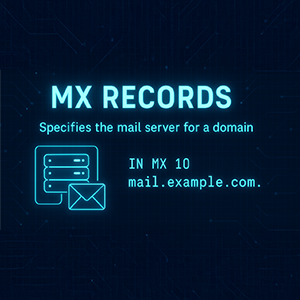Understanding MX Records in DNS
MX records, short for Mail Exchange records, are critical for email delivery. They tell the world which mail servers are responsible for receiving emails for your domain. Without proper MX records, your domain can’t receive email, and senders will receive bounce messages or delivery failures.
What Is an MX Record?
An MX record directs email traffic by pointing your domain to the mail server that should handle its messages. Each MX record has two parts: a priority number and a mail server domain name. For example:

This example shows that email for example.com should be routed to mail.example.com, with a priority of 10.
The mail server itself must also have an A or AAAA record that resolves to an IP address.
Without a valid MX record, email for your domain will fail to arrive.
How MX Record Priorities Work
When you define multiple MX records, the one with the lowest priority number is used first. If that server is unavailable, the next lowest is tried. This allows for fallback and improved uptime.
10 mail1.example.com
20 mail2.example.com
In this case, mail1 is the primary server, and mail2 acts as backup.
How to Look Up an MX Record
You can check your MX records using built-in tools on your system. Here’s how:
Windows
1. Open cmd or PowerShell.
2. Enter this command:
macOS
1. Open Terminal.
2. Type one of the following:
or
Linux
1. Open your terminal.
2. Use either command:
or
Why MX Records Matter
- They are required for email delivery to your domain.
- They support multiple mail servers for redundancy and failover.
- They work together with SPF, DKIM, and DMARC for email security.
- They must point to domain names, not raw IP addresses.
Managing MX Records
You can configure your MX records through your DNS provider’s dashboard. This may be your domain registrar (like Namecheap or GoDaddy) or a DNS service like Cloudflare, DigitalOcean, or AWS Route 53.
- Registrar DNS: Basic dashboards allow direct edits to MX records.
- External DNS: Advanced control and DNS analytics through third-party platforms.
Make sure to replicate your MX settings if switching providers to avoid email downtime.
Example: Google Workspace
Google Workspace uses multiple MX records to route mail. Here’s what that might look like:
1 ASPMX.L.GOOGLE.COM.
5 ALT1.ASPMX.L.GOOGLE.COM.
5 ALT2.ASPMX.L.GOOGLE.COM.
10 ALT3.ASPMX.L.GOOGLE.COM.
10 ALT4.ASPMX.L.GOOGLE.COM.
MX vs SPF, DKIM, and DMARC
MX records alone are not enough to protect your email. They should work alongside:
- SPF: Defines authorized senders for your domain.
- DKIM: Adds digital signatures to outgoing emails.
- DMARC: Tells recipients how to handle failed SPF/DKIM checks.
Together, they ensure your domain can send and receive email securely.
Summary
MX records are the gateway to your domain’s inbox. They route incoming email to the correct server and enable redundancy through priority settings. Whether you're setting up a personal domain or managing a corporate mail system, understanding how MX records work is essential to running reliable and secure email services.
